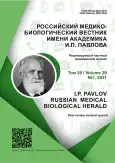Radiofrequency obliteration in treatment of venous angiodysplasia
- Authors: Sapelkin S.V.1, Druzhinina N.A.1, Chupin A.V.1, Golovyuk A.L.1, Abrosimov A.V.1
-
Affiliations:
- Vishnevsky National Medical Research Center of Surgery
- Issue: Vol 29, No 1 (2021)
- Pages: 89-98
- Section: Original study
- URL: https://journals.rcsi.science/pavlovj/article/view/54562
- DOI: https://doi.org/10.23888/PAVLOVJ202129189-98
- ID: 54562
Cite item
Abstract
Aim. This study aimed to investigate potential use of radiofrequency obliteration (RFO) of angiomatous tissues in patients with venous malformations.
Materials and Methods. A single-center study retrospectively involved 42 clinical cases [57.1% of men (n=24), aged 18-44 years; 42.8% of women (n=18) aged 18-56 years] of venous angiodysplasia, with a total of 46 interventions using RFO. Clinical manifestations of the disease were primarily characterized by pain syndrome (71.4%), cosmetic defect (100%), and edema syndrome (95.2%).
Results. Clinical improvement was possibly achieved with the reduction of the intensity of manifestations of angiomatous processes in 37 patients (88.1%). Stable and partial obliterations of caverns in the zone of exposure to radiofrequency were recorded in 37 (88.0%) and 5 (12.0%) patients, respectively. In caverns with small diameter, obliteration was achieved in 100% of the cases. Postoperative complications included bleeding (2.4%), burns in the zone of electrode introduction (2.4%), lymphorrhea (2.4%), and hypesthesia (2.4%). With this, according to the results of duplex scanning performed on control visits, no significant disease progression was observed. In the same patient, several complications could occur. All complications regressed within a month and required no treatment in hospital conditions.
Conclusion. RFO showed advantage as a minimally invasive treatment method of venous angiodysplasias. Results suggest that RFO can be recommended for use in patients with >1 cm depth of lesion with caverns of medium and large diameter as an independent treatment method and in combination with standard resection methods.
Full Text
##article.viewOnOriginalSite##About the authors
Sergey V. Sapelkin
Vishnevsky National Medical Research Center of Surgery
Email: ssapelkin@yandex.ru
ORCID iD: 0000-0003-3610-8382
SPIN-code: 3040-0699
ResearcherId: A-5742-2016
MD, PhD, Professor, Leading Researcher of the Vascular Surgery Department
Russian Federation, Moscow, RussiaNatalia A. Druzhinina
Vishnevsky National Medical Research Center of Surgery
Author for correspondence.
Email: dna13@mail.ru
ORCID iD: 0000-0002-6994-7310
SPIN-code: 9124-0358
ResearcherId: ABG-9603-2020
Junior Researcher of the Vascular Surgery Department
Russian Federation, Moscow, RussiaAndrey V. Chupin
Vishnevsky National Medical Research Center of Surgery
Email: info@eco-vector.com
SPIN-code: 7237-4582
MD, PhD, Head of the Vascular Surgery Department
Russian Federation, Moscow, RussiaAleksandr L. Golovyuk
Vishnevsky National Medical Research Center of Surgery
Email: algolovyuk@inbox.ru
ORCID iD: 0000-0001-6830-7832
SPIN-code: 9976-7041
Scopus Author ID: 57193929365
MD, PhD, Doctor of the Vascular Surgery Department
Russian Federation, Moscow, RussiaAleksey V. Abrosimov
Vishnevsky National Medical Research Center of Surgery
Email: abrosimov.alexey@yandex.ru
ORCID iD: 0000-0001-6539-5363
SPIN-code: 7322-1401
ResearcherId: ABG-5603-2020
Resident of the Vascular Surgery Department
Russian Federation, Moscow, RussiaReferences
- Ernemann U, Kramer U, Miller S, et al. Current concepts in the classification, diagnosis and treatment of vascular anomalies. European Journal of Radiology. 2010;75(1):2-11. doi: 10.1016/j.ejrad. 2010.04.009
- Angiodisplazii (vrozhdennyye poroki razvitiya sosudov). Moscow: Verdana; 2008. (In Russ).
- Clemens RK, Pfammatter T, Meier TO, et al. Vascular malformations revisited. Vasa. 2015;44(1):5-22. doi: 10.1024/0301-1526/a000402
- Dompmartin A, Vikkula M, Boon LM. Venous malformation: update on aetiopathogenesis, diagnosis and management. Phlebology. 2010;25(5):224-35. doi: 10.1258/phleb.2009.009041
- Popel GA. The diagnosis and surgical treatment of angiodysplasia of external localization. Novosti Khirurgii. 2014;22(5):601-10. (In Russ).
- Van der Linden E, Overbosch J, Kroft LJM. Radiofrequency ablation for treatment of symptomatic low-flow vascular malformations after previous unsuccessful therapy. Journal of Vascular and Interventional Radiology. 2005;16(5):747-50. doi:10.1097/ 01.RVI.0000157245.60426.7B
- Kim AH, Ko HK, Won JY, et al. Percutaneous radiofrequency ablation: a novel treatment of facial venous malformation. Journal of Vascular Surgery. 2009;50(2):424-7. doi:10.1016/ j.jvs.2009.03.047
- Behravesh S, Yakes W, Gupta N, et al. Venous malformations: clinical diagnosis and treatment. Cardiovascular Diagnosis and Therapy. 2016;6(6): 557-69. doi: 10.21037/cdt.2016.11.10
- Gao Y, Wang X, Suo W. Management of venous malformations with percutaneous radiofrequency thermal ablation. British Journal of Dermatology. 2012;167(3):637-42. doi: 10.1111/j.1365-2133.2012. 10963.x
Supplementary files










